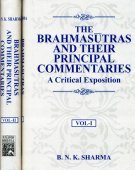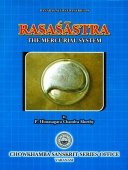Parabrahman, Parabrahmā, Parabrahma, Para-brahman: 15 definitions
Introduction:
Parabrahman means something in Hinduism, Sanskrit, the history of ancient India. If you want to know the exact meaning, history, etymology or English translation of this term then check out the descriptions on this page. Add your comment or reference to a book if you want to contribute to this summary article.
Parabrahman has 13 English definitions available.
Languages of India and abroad
Sanskrit dictionary
[Deutsch Wörterbuch]
Source: Cologne Digital Sanskrit Dictionaries: Böhtlingk and Roth Grosses Petersburger WörterbuchParabrahman (परब्रह्मन्):—(para + bra) n. das höchste Brahman [Bhartṛhari 3, 96.] Titel einer Upaniṣad [Weber’s Indische Studien 3, 326, 3.]
Source: Cologne Digital Sanskrit Dictionaries: Sanskrit-Wörterbuch in kürzerer FassungParabrahman (परब्रह्मन्):—n. —
1) das höchste Brahman. —
2) Titel einer Upaniṣad. brahmopaniṣad f. [Private libraries (Gustav) 1.]
Sanskrit, also spelled संस्कृतम् (saṃskṛtam), is an ancient language of India commonly seen as the grandmother of the Indo-European language family (even English!). Closely allied with Prakrit and Pali, Sanskrit is more exhaustive in both grammar and terms and has the most extensive collection of literature in the world, greatly surpassing its sister-languages Greek and Latin.
See also (Relevant definitions)
Partial matches: Brahman, Brahma, Para.
Starts with: Parabrahmana, Parabrahmanadi, Parabrahmanandabodha.
Full-text (+32): Parabrahmastotra, Parabrahmaprakashika, Aparabrahma, Parabrahmopanishad, Parabrahmanandabodha, Parabomma, Parabrahmashtottarashatanaman, Niravayava, Nityananda, Parapurusha, Amgavabaddha, Dimba, Highest brahma, Sacara, Parappiramam, Rasa, Vyakta, Ananjana, Shuci, Hindudharma.
Relevant text
Search found 73 books and stories containing Parabrahman, Para-brahma, Para-brahmā, Parabrahmā, Parabrahma, Para-brahman; (plurals include: Parabrahmans, brahmas, brahmās, Parabrahmās, Parabrahmas, brahmans). You can also click to the full overview containing English textual excerpts. Below are direct links for the most relevant articles:
Brihad Bhagavatamrita (commentary) (by Śrī Śrīmad Bhaktivedānta Nārāyana Gosvāmī Mahārāja)
Verse 2.2.194 < [Chapter 2 - Jñāna (knowledge)]
Verse 2.3.34 < [Chapter 3 - Bhajana (loving service)]
Verse 2.2.178 < [Chapter 2 - Jñāna (knowledge)]
Prasthanatrayi Swaminarayan Bhashyam (Study) (by Sadhu Gyanananddas)
2. Īśvara (Introduction) < [Chapter 3 - Analysis on the Basis of Metaphysics]
6.3. Why Does the Jīvanmukta Live on Earth? < [Chapter 5 - Analysis on the basis of Soteriology]
4. Akṣarabrahman (Introduction) < [Chapter 3 - Analysis on the Basis of Metaphysics]
Gitartha Samgraha (critical Study) (by Partha Sarathi Sil)
6. Concept of Īśvara in the Gītārthasaṅgraha < [Chapter 4 - Critical Study of the Gītārthasaṅgraha]
8. Śivādvayavāda in the Gītārthasaṅgraha < [Chapter 4 - Critical Study of the Gītārthasaṅgraha]
4. Tattvas (Principles) of Kashmir Śaivism in the Gītārthasaṅgraha < [Chapter 3 - A Brief Sketch of Kashmir Śaivism]
Shrimad Bhagavad-gita (by Narayana Gosvami)
Verse 8.3 < [Chapter 8 - Tāraka-brahma-yoga (the Yoga of Absolute Deliverance)]
Verse 14.27 < [Chapter 14 - Guṇa-traya-vibhāga-yoga]
Verse 13.13 < [Chapter 13 - Prakṛti-puruṣa-vibhāga-yoga]
The Devi Bhagavata Purana (by Swami Vijñanananda)
Chapter 2 - On the origin of Prakṛti and Puruṣa < [Book 9]
Chapter 8 - On the greatness of Kali < [Book 9]
Chapter 39 - The Worship of the World Mother < [Book 7]
The Bhagavata Purana (by G. V. Tagare)
Chapter 6 - Appeasement of Rudra—Revival of Dakṣa < [Book 4 - Fourth Skandha]
Chapter 32 - Excellence of the Bhaktiyoga < [Book 3 - Third Skandha]
Chapter 28 - Nanda rescued from Varuṇa < [Book 10 - Tenth Skandha]
Related products


